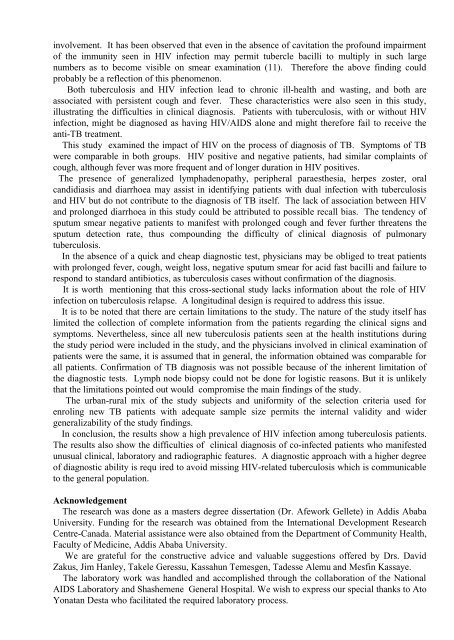Original article - Ethiopian Review
Original article - Ethiopian Review
Original article - Ethiopian Review
- No tags were found...
You also want an ePaper? Increase the reach of your titles
YUMPU automatically turns print PDFs into web optimized ePapers that Google loves.
involvement. It has been observed that even in the absence of cavitation the profound impairmentof the immunity seen in HIV infection may permit tubercle bacilli to multiply in such largenumbers as to become visible on smear examination (11). Therefore the above finding couldprobably be a reflection of this phenomenon.Both tuberculosis and HIV infection lead to chronic ill-health and wasting, and both areassociated with persistent cough and fever. These characteristics were also seen in this study,illustrating the difficulties in clinical diagnosis. Patients with tuberculosis, with or without HIVinfection, might be diagnosed as having HIV/AIDS alone and might therefore fail to receive theanti-TB treatment.This study examined the impact of HIV on the process of diagnosis of TB. Symptoms of TBwere comparable in both groups. HIV positive and negative patients, had similar complaints ofcough, although fever was more frequent and of longer duration in HIV positives.The presence of generalized lymphadenopathy, peripheral paraesthesia, herpes zoster, oralcandidiasis and diarrhoea may assist in identifying patients with dual infection with tuberculosisand HIV but do not contribute to the diagnosis of TB itself. The lack of association between HIVand prolonged diarrhoea in this study could be attributed to possible recall bias. The tendency ofsputum smear negative patients to manifest with prolonged cough and fever further threatens thesputum detection rate, thus compounding the difficulty of clinical diagnosis of pulmonarytuberculosis.In the absence of a quick and cheap diagnostic test, physicians may be obliged to treat patientswith prolonged fever, cough, weight loss, negative sputum smear for acid fast bacilli and failure torespond to standard antibiotics, as tuberculosis cases without confirmation of the diagnosis.It is worth mentioning that this cross-sectional study lacks information about the role of HIVinfection on tuberculosis relapse. A longitudinal design is required to address this issue.It is to be noted that there are certain limitations to the study. The nature of the study itself haslimited the collection of complete information from the patients regarding the clinical signs andsymptoms. Nevertheless, since all new tuberculosis patients seen at the health institutions duringthe study period were included in the study, and the physicians involved in clinical examination ofpatients were the same, it is assumed that in general, the information obtained was comparable forall patients. Confirmation of TB diagnosis was not possible because of the inherent limitation ofthe diagnostic tests. Lymph node biopsy could not be done for logistic reasons. But it is unlikelythat the limitations pointed out would compromise the main findings of the study.The urban-rural mix of the study subjects and uniformity of the selection criteria used forenroling new TB patients with adequate sample size permits the internal validity and widergeneralizability of the study findings.In conclusion, the results show a high prevalence of HIV infection among tuberculosis patients.The results also show the difficulties of clinical diagnosis of co-infected patients who manifestedunusual clinical, laboratory and radiographic features. A diagnostic approach with a higher degreeof diagnostic ability is requ ired to avoid missing HIV-related tuberculosis which is communicableto the general population.AcknowledgementThe research was done as a masters degree dissertation (Dr. Afework Gellete) in Addis AbabaUniversity. Funding for the research was obtained from the International Development ResearchCentre-Canada. Material assistance were also obtained from the Department of Community Health,Faculty of Medicine, Addis Ababa University.We are grateful for the constructive advice and valuable suggestions offered by Drs. DavidZakus, Jim Hanley, Takele Geressu, Kassahun Temesgen, Tadesse Alemu and Mesfin Kassaye.The laboratory work was handled and accomplished through the collaboration of the NationalAIDS Laboratory and Shashemene General Hospital. We wish to express our special thanks to AtoYonatan Desta who facilitated the required laboratory process.




![to read the full report [pdf, Amharic] - Ethiopian Review](https://img.yumpu.com/52737829/1/190x245/to-read-the-full-report-pdf-amharic-ethiopian-review.jpg?quality=85)











